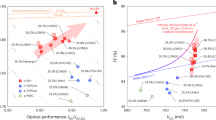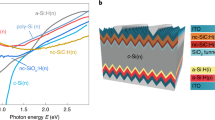Abstract
A salient characteristic of solar cells is their ability to subject photo-generated electrons and holes to pathways of asymmetrical conductivity—‘assisting’ them towards their respective contacts. All commercially available crystalline silicon (c-Si) solar cells achieve this by making use of doping in either near-surface regions or overlying silicon-based films. Despite being commonplace, this approach is hindered by several optoelectronic losses and technological limitations specific to doped silicon. A progressive approach to circumvent these issues involves the replacement of doped-silicon contacts with alternative materials which can also form ‘carrier-selective’ interfaces on c-Si. Here we successfully develop and implement dopant-free electron and hole carrier-selective heterocontacts using alkali metal fluorides and metal oxides, respectively, in combination with passivating intrinsic amorphous silicon interlayers, resulting in power conversion efficiencies approaching 20%. Furthermore, the simplified architectures inherent to this approach allow cell fabrication in only seven low-temperature (≤200 ∘C), lithography-free steps. This is a marked improvement on conventional doped-silicon high-efficiency processes, and highlights potential improvements on both sides of the cost-to-performance ratio for c-Si photovoltaics.
This is a preview of subscription content, access via your institution
Access options
Subscribe to this journal
Receive 12 digital issues and online access to articles
$119.00 per year
only $9.92 per issue
Buy this article
- Purchase on Springer Link
- Instant access to full article PDF
Prices may be subject to local taxes which are calculated during checkout




Similar content being viewed by others
References
Baker-Finch, S. C., McIntosh, K. R., Yan, D., Fong, K. C. & Kho, T. C. Near-infrared free carrier absorption in heavily doped silicon. J. Appl. Phys. 116, 063106 (2014).
Richter, A., Glunz, S. W., Werner, F., Schmidt, J. & Cuevas, A. Improved quantitative description of Auger recombination in crystalline silicon. Phys. Rev. B 86, 165202 (2012).
Cuevas, A., Basore, P. A., Giroult-Matlakowski, G. & Dubois, C. Surface recombination velocity of highly doped n-type silicon. J. Appl. Phys. 80, 3370–3375 (1996).
Zhao, J., Wang, A., Green, M. A. & Ferrazza, F. 19.8% efficient ‘honeycomb’ textured multicrystalline and 24.4% monocrystalline silicon solar cells. Appl. Phys. Lett. 73, 1991–1993 (1998).
Goodrich, A. et al. A wafer-based monocrystalline silicon photovoltaics road map: utilizing known technology improvement opportunities for further reductions in manufacturing costs. Sol. Energy Mater. Sol. Cells 114, 110–135 (2013).
Tiedje, T., Yablonovitch, E., Cody, G. D. & Brooks, B. G. Limiting efficiency of silicon solar cells. IEEE Trans. Electron Devices 31, 711–716 (1984).
Wurfel, U., Cuevas, A. & Wurfel, P. Charge carrier separation in solar cells. IEEE J. Photovolt. 5, 461–469 (2015).
Masuko, K. et al. Achievement of more than 25%; conversion efficiency with crystalline silicon heterojunction solar cell. IEEE J. Photovolt. 4, 1433–1435 (2014).
Taguchi, M. et al. 24.7%; record efficiency HIT solar cell on thin silicon wafer. IEEE J. Photovolt. 4, 96–99 (2014).
Heng, J. B. et al. >23% high-efficiency tunnel oxide junction bifacial solar cell with electroplated Cu gridlines. IEEE J. Photovolt. 5, 82–86 (2015).
Feldmann, F. et al. Efficient carrier-selective p- and n-contacts for Si solar cells. Sol. Energy Mater. Sol. Cells 131, 100–104 (2014).
Holman, Z. C. et al. Current losses at the front of silicon heterojunction solar cells. IEEE J. Photovolt. 2, 7–15 (2012).
Fujiwara, H. & Kondo, M. Effects of a-Si:H layer thicknesses on the performance of a-Si:H/c-Si heterojunction solar cells. J. Appl. Phys. 101, 054516 (2007).
de Nicolás, S. M., Muñoz, D., Ozanne, A. S., Nguyen, N. & Ribeyron, P. J. Proc. SiliconPV 2011 Conf. 1st Int. Conf. Cryst. Silicon Photovolt. Vol. 8, 226–231 (2011).
Yang, J.-H., Kang, S. J., Hong, Y. & Lim, K. S. Doping-free intrinsic amorphous silicon thin-film solar cell having a simple structure of Glass/SnO2/MoO3/i-a-Si/LiF/Al. IEEE Electron Device Lett. 35, 96–98 (2014).
Avasthi, S. et al. Hole-blocking titanium-oxide/silicon heterojunction and its application to photovoltaics. Appl. Phys. Lett. 102, 203901 (2013).
Battaglia, C. et al. Hole selective MoOx contact for silicon solar cells. Nano Lett. 14, 967–971 (2014).
Bullock, J., Cuevas, A., Allen, T. & Battaglia, C. Molybdenum oxide MoOx: a versatile hole contact for silicon solar cells. Appl. Phys. Lett. 105, 232109 (2014).
Bivour, M., Temmler, J., Steinkemper, H. & Hermle, M. Molybdenum and tungsten oxide: high work function wide band gap contact materials for hole selective contacts of silicon solar cells. Sol. Energy Mater. Sol. Cells 142, 34–41 (2015).
Zielke, D., Pazidis, A., Werner, F. & Schmidt, J. Organic-silicon heterojunction solar cells on n-type silicon wafers: the BackPEDOT concept. Sol. Energy Mater. Sol. Cells 131, 110–116 (2014).
Yu, P. et al. 13% efficiency hybrid organic/silicon-nanowire heterojunction solar cell via interface engineering. ACS Nano 7, 10780–10787 (2013).
Shen, X., Sun, B., Liu, D. & Lee, S.-T. Hybrid heterojunction solar cell based on organic–inorganic silicon nanowire array architecture. J. Am. Chem. Soc. 133, 19408–19415 (2011).
Hezel, R. Recent progress in MIS solar cells. Prog. Photovolt. Res. Appl. 5, 109–120 (1997).
Ponpon, J. P. & Siffert, P. Open circuit voltage of MIS silicon solar cells. J. Appl. Phys. 47, 3248–3251 (1976).
Singh, R., Green, M. A. & Rajkanan, K. Review of conductor–insulator–semiconductor (CIS) solar cells. Sol. Cells 3, 95–148 (1981).
Chen, L.-M., Xu, Z., Hong, Z. & Yang, Y. Interface investigation and engineering—achieving high performance polymer photovoltaic devices. J. Mater. Chem. 20, 2575–2598 (2010).
Yin, X. et al. 19.2% efficient InP heterojunction solar cell with electron-selective TiO2 contact. ACS Photon. 1, 1245–1250 (2014).
Zhou, H. et al. Interface engineering of highly efficient perovskite solar cells. Science 345, 542–546 (2014).
Liu, R., Lee, S.-T. & Sun, B. 13.8% efficiency hybrid Si/organic heterojunction solar cells with MoO3 film as antireflection and inversion induced layer. Adv. Mater. 26, 6007–6012 (2014).
Nagamatsu, K. A. et al. Titanium dioxide/silicon hole-blocking selective contact to enable double-heterojunction crystalline silicon-based solar cell. Appl. Phys. Lett. 106, 123906 (2015).
Zhang, Y. et al. High efficiency hybrid PEDOT:PSS/nanostructured silicon Schottky junction solar cells by doping-free rear contact. Energy Environ. Sci. 8, 297–302 (2015).
Zhang, Y., Liu, R., Lee, S.-T. & Sun, B. The role of a LiF layer on the performance of poly(3,4-ethylenedioxythiophene):poly(styrenesulfonate)/Si organic-inorganic hybrid solar cells. Appl. Phys. Lett. 104, 083514 (2014).
Battaglia, C. et al. Silicon heterojunction solar cell with passivated hole selective MoOx contact. Appl. Phys. Lett. 104, 113902 (2014).
Geissbühler, J. et al. 22.5% efficient silicon heterojunction solar cell with molybdenum oxide hole collector. Appl. Phys. Lett. 107, 081601 (2015).
Li, Y. et al. Elucidation of the electron injection mechanism of evaporated cesium carbonate cathode interlayer for organic light-emitting diodes. Appl. Phys. Lett. 90, 012119 (2007).
Ganzorig, C., Suga, K. & Fujihira, M. Alkali metal acetates as effective electron injection layers for organic electroluminescent devices. Mater. Sci. Eng. B 85, 140–143 (2001).
Helander, M. G., Wang, Z. B., Mordoukhovski, L. & Lu, Z. H. Comparison of Alq3/alkali-metal fluoride/Al cathodes for organic electroluminescent devices. J. Appl. Phys. 104, 094510 (2008).
Hung, L. S., Tang, C. W. & Mason, M. G. Enhanced electron injection in organic electroluminescence devices using an Al/LiF electrode. Appl. Phys. Lett. 70, 152–154 (1997).
Descoeudres, A. et al. >21%; efficient silicon heterojunction solar cells on n- and p-type wafers compared. IEEE J. Photovolt. 3, 83–89 (2013).
Bullock, J. et al. Proof-of-concept p-type silicon solar cells with molybdenum oxide local rear contacts. IEEE J. Photovolt. 5, 1591–1594 (2015).
Kim, S. et al. Effects of LiF/Al back electrode on the amorphous/crystalline silicon heterojunction solar cells. Adv. Mater. Charact. Tech. Sol. Cells 178, 660–664 (2013).
Schroder, D. K. Semiconductor Material and Device Characterization (John Wiley, 2006).
Gogolin, R. et al. Analysis of series resistance losses in a-Si:H/c-Si heterojunction solar cells. IEEE J. Photovolt. 4, 1169–1176 (2014).
Feldmann, F., Bivour, M., Reichel, C., Hermle, M. & Glunz, S. W. Passivated rear contacts for high-efficiency n-type Si solar cells providing high interface passivation quality and excellent transport characteristics. Sol. Energy Mater. Sol. Cells 120, 270–274 (2014).
Franklin, E. et al. Design, fabrication and characterisation of a 24.4% efficient interdigitated back contact solar cell. Prog. Photovolt. Res. Appl. http://dx.doi.org/10.1002/pip.2556 (2014).
Demaurex, B. et al. Atomic-layer-deposited transparent electrodes for silicon heterojunction solar cells. IEEE J. Photovolt. 4, 1387–1396 (2014).
Morales-Masis, M., De Nicolas, S. M., Holovsky, J., De Wolf, S. & Ballif, C. Low-temperature high-mobility amorphous IZO for silicon heterojunction solar cells. IEEE J. Photovolt. 5, 1340–1347 (2015).
Dupuis, J. et al. Photovoltaic Specialists Conference (PVSC), 2012 38th IEEE 003183–003186 (IEEE, 2012); http://dx.doi.org/10.1109/PVSC.2012.6318254
Briggs, D. & Seah, P. Practical Surface Analysis, Auger and X-ray Photoelectron Spectroscopy 635–638 (Wiley, 1990).
Scanlon, D. O. et al. Theoretical and experimental study of the electronic structures of MoO3 and MoO2 . J. Phys. Chem. C 114, 4636–4645 (2010).
Hamrin, K., Johansson, G., Gelius, U., Nordling, C. & Siegbahn, K. Valence bands and core levels of the isoelectronic series LiF, BeO, BN, and graphite studied by ESCA. Phys. Scr. 1, 277–280 (1970).
Acknowledgements
We would like to thank P. Frischmann for his assistance with I–V measurements and A. Fell for his suggestions regarding the simulations. Device design, fabrication and characterization were funded by the Bay Area Photovoltaics Consortium (BAPVC). Materials characterization was supported by the Electronic Materials Programs, funded by the Director, Office of Science, Office of Basic Energy Sciences, Material Sciences and Engineering Division of the US Department of Energy under Contract No. DE-AC02- 05CH11231. XPS characterization was performed at the Joint Center for Artificial Photosynthesis, supported through the Office of Science of the US Department of Energy under Award Number DE-SC0004993. Work at the Molecular Foundry was supported by the Office of Science, Office of Basic Energy Sciences, of the US Department of Energy (Contract No. DE-AC02-05CH11231). Work at EPFL was supported by the Office fedéral de l’ énergie (OFEN). Work at the ANU was supported by the Australian Renewable Energy Agency (ARENA). The authors would like to thank the CSEM PV-center for wafer preparation and device metallization.
Author information
Authors and Affiliations
Contributions
J.B. and A.J. conceived the idea. J.B. and J.G. carried out the device fabrication, electrical characterization and analysis. A.J.O., T.A. and T.C. assisted with device fabrication. M.H. and C.M.S.-F., assisted with materials characterization. H.O. and E.W.S. assisted with mask fabrication. A.C., S.D.W. and C.B. discussed the results. J.B. wrote the paper and all other authors provided feedback.
Corresponding author
Ethics declarations
Competing interests
The authors declare no competing financial interests.
Supplementary information
Supplementary Information
Supplementary Notes 1-4, Supplementary Tables 1-3, Supplementary Figures 1-4, Supplementary References. (PDF 911 kb)
Rights and permissions
About this article
Cite this article
Bullock, J., Hettick, M., Geissbühler, J. et al. Efficient silicon solar cells with dopant-free asymmetric heterocontacts. Nat Energy 1, 15031 (2016). https://doi.org/10.1038/nenergy.2015.31
Received:
Accepted:
Published:
DOI: https://doi.org/10.1038/nenergy.2015.31
This article is cited by
-
Statistical analysis of cost-effective silicon solar cell with SnSe as BSF layer and metal oxide emitters
Indian Journal of Physics (2024)
-
The structural, optical, and electrical properties of thermal evaporation-deposited V2OX films for use in silicon heterojunction solar cells
Journal of Materials Science: Materials in Electronics (2023)
-
Stable and Efficient Hole Selective Contacts for Silicon Photovoltaics via Solution-Processed Luminescent Small Molecules
Journal of Electronic Materials (2023)
-
Simulation and optimization of dopant-free asymmetric heterojunction solar cells
Optoelectronics Letters (2023)
-
Bulk Parameters Effect and Comparative Performance Analysis of p-Si/n-CdS/ALD-ZnO Solar Cell
Silicon (2023)



